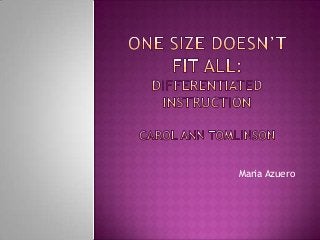
Carol anne tomlinson
- 1. Maria Azuero
- 2. Carol Ann Tomlinson is an English educator, author and speaker. Sheis best known for her innovative work with Differentiated instruction education techniques. Tomlinsonis a reviewer for eight journals and has authored over 200 articles, books, and other professional development materials.
- 3. It is an approach to teaching that advocates active planning for student differences in classrooms. Creating multiple paths so that students of different abilities, interest or learning requirements experience equally appropriate ways to absorb, use, develop and present concepts as a part of the daily learning process (Tomlinson, 2000).
- 4. Differentiated Instruction is a concept that has existed for a long time but it’s now being used in classrooms. Itis the concept that every child is able to learn according to their own learning styles, readiness levels and interest. When planning a differentiated classroom there should be three areas to always consider: Content, Process and Product.
- 5. CONTENT: -Can be described as the knowledge, skills and attitudes we want people to learn according to Webster´s Dictionary. - To differentiate content is simply to permit the more advance students to accelerate their rate of progress. They can work ahead independently on some projects, i.e. they cover the content faster than their peers. -The content can also be differentiated by using different texts, novels or short stories at a reading level appropriate for each individual student.
- 6. PROCESS: -Differentiating the processes means varying learning activities or strategies to provide appropriate methods for students to explore the concepts. - It is important to give students alternative paths to manipulate the ideas embedded within the concept. Develop activities that target auditory, visual, and kinesthetic learners. -For example, students may use graphic organizers, maps, diagrams or charts to display their comprehension of concepts covered.
- 7. PRODUCT: -When an educator differentiates by product or performance, they are offering students various ways of demonstrating what they have learned from the lesson or unit -Differentiating the product means varying the complexity of the product that students create to demonstrate understanding of the concepts
- 8. Advantages: Target every type of learner Confidence Success Disadvantages: Time Consuming More work
